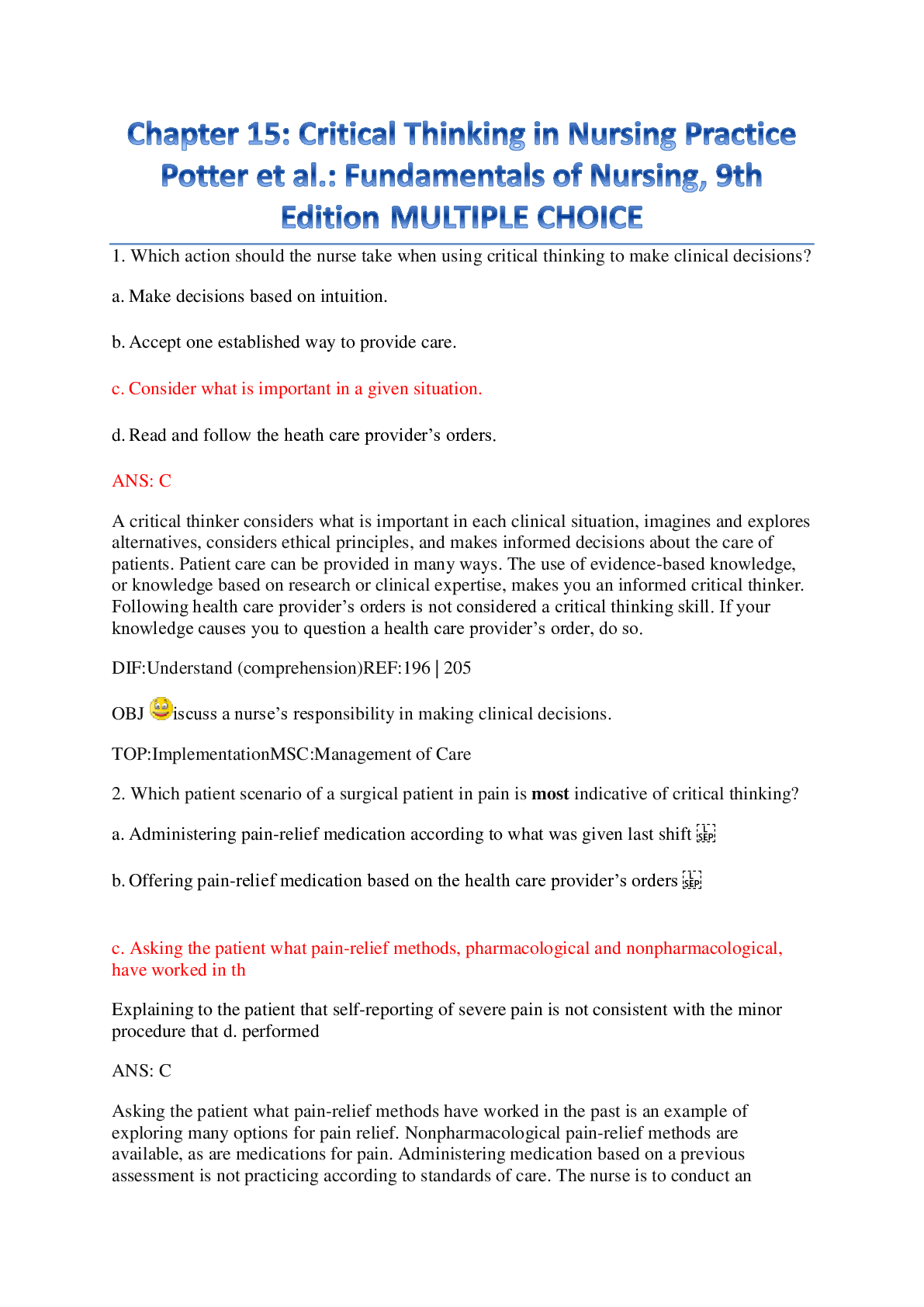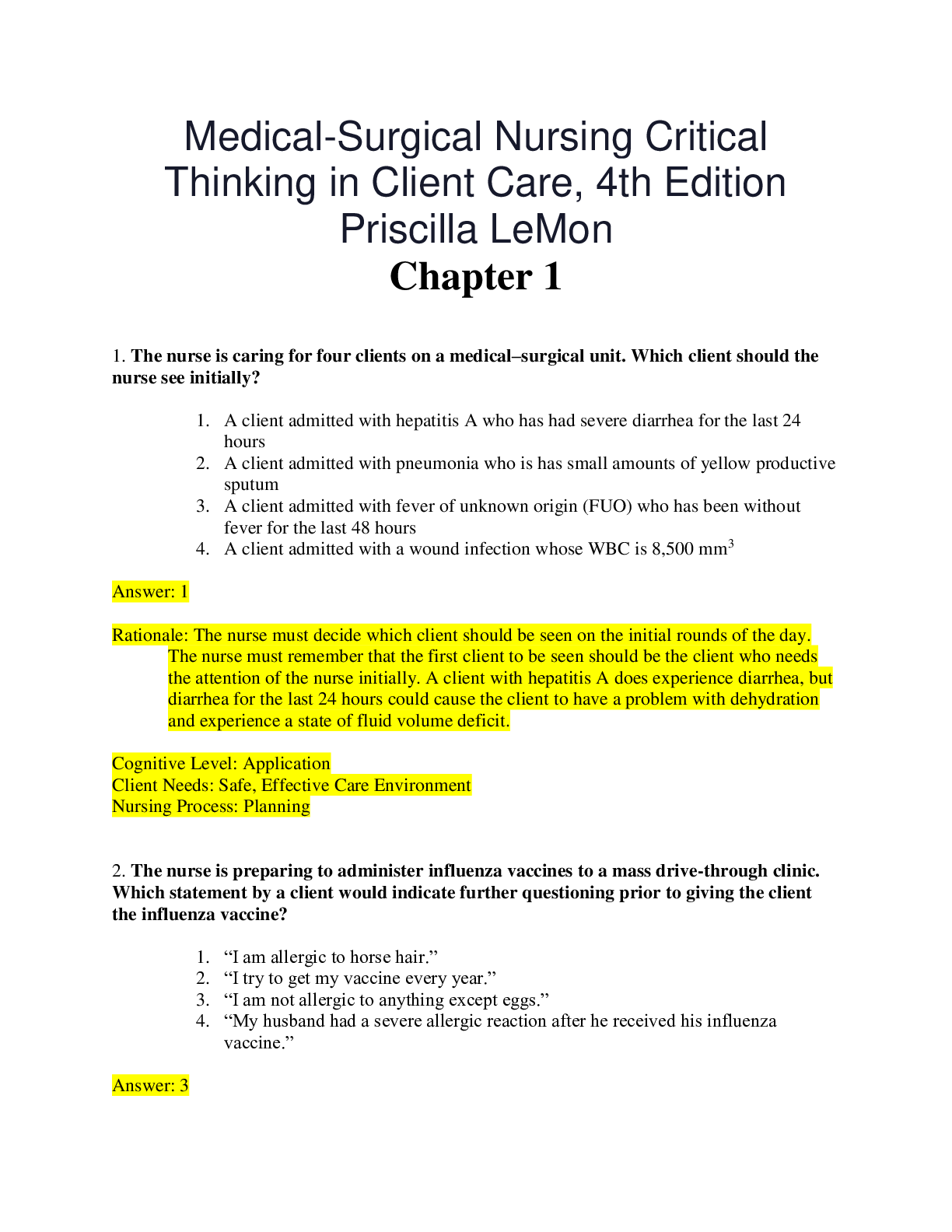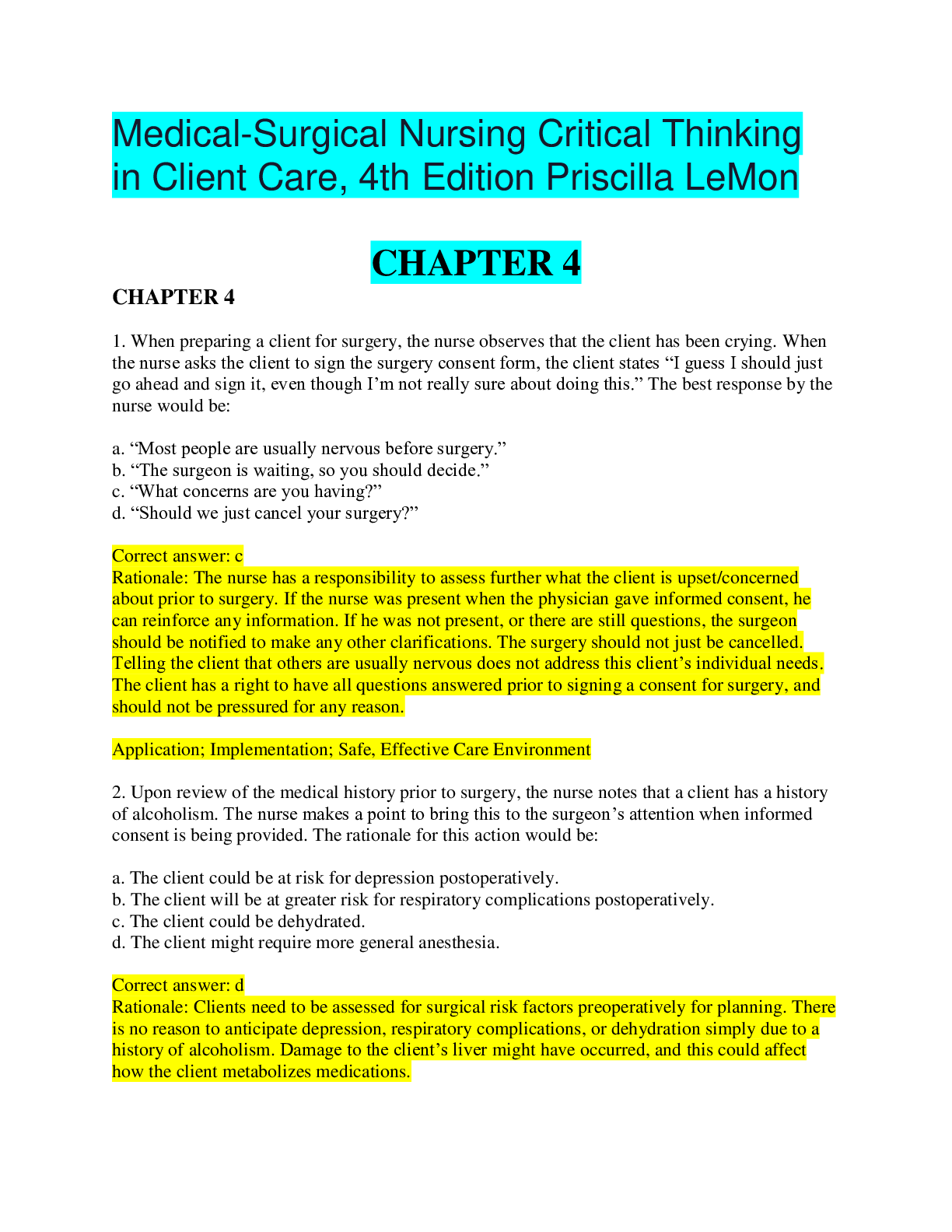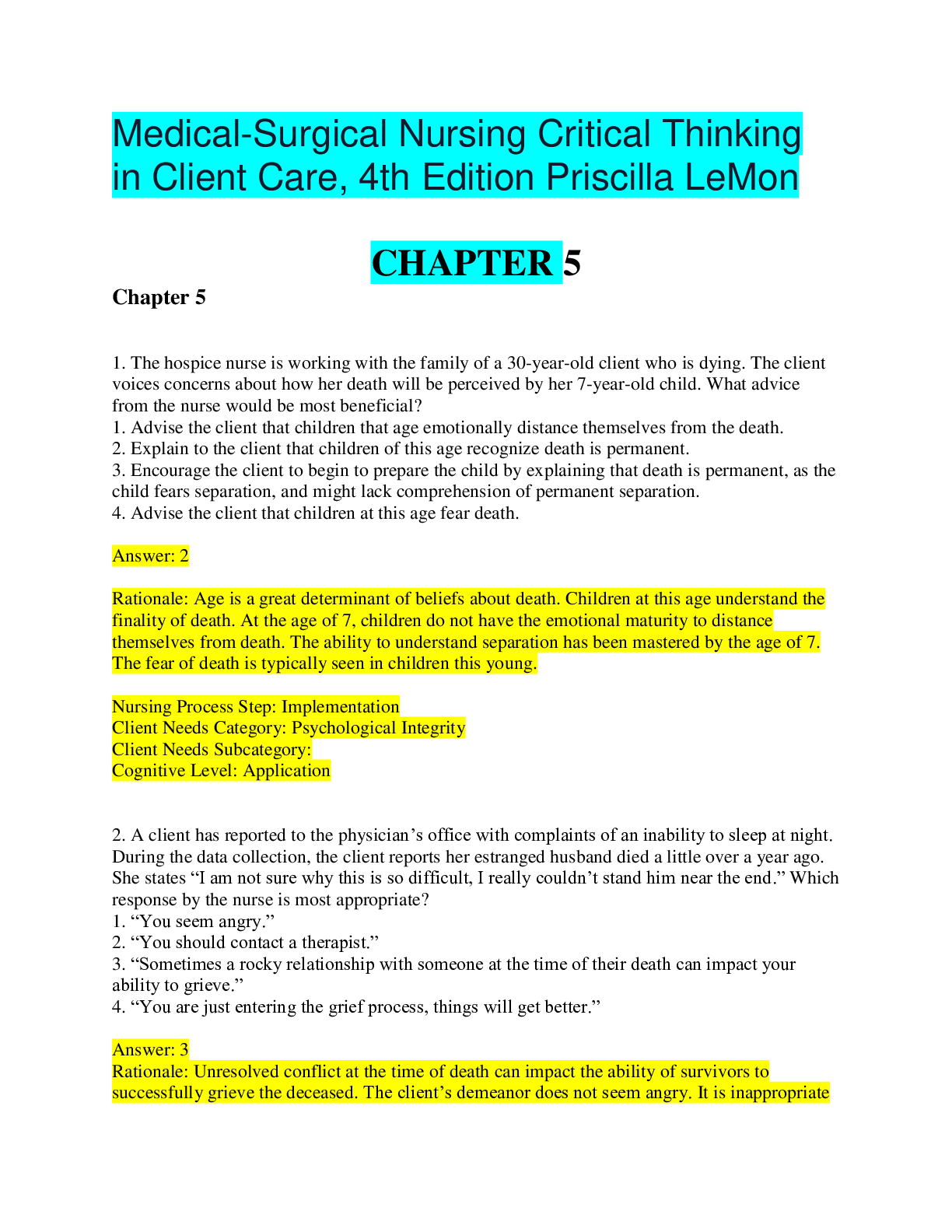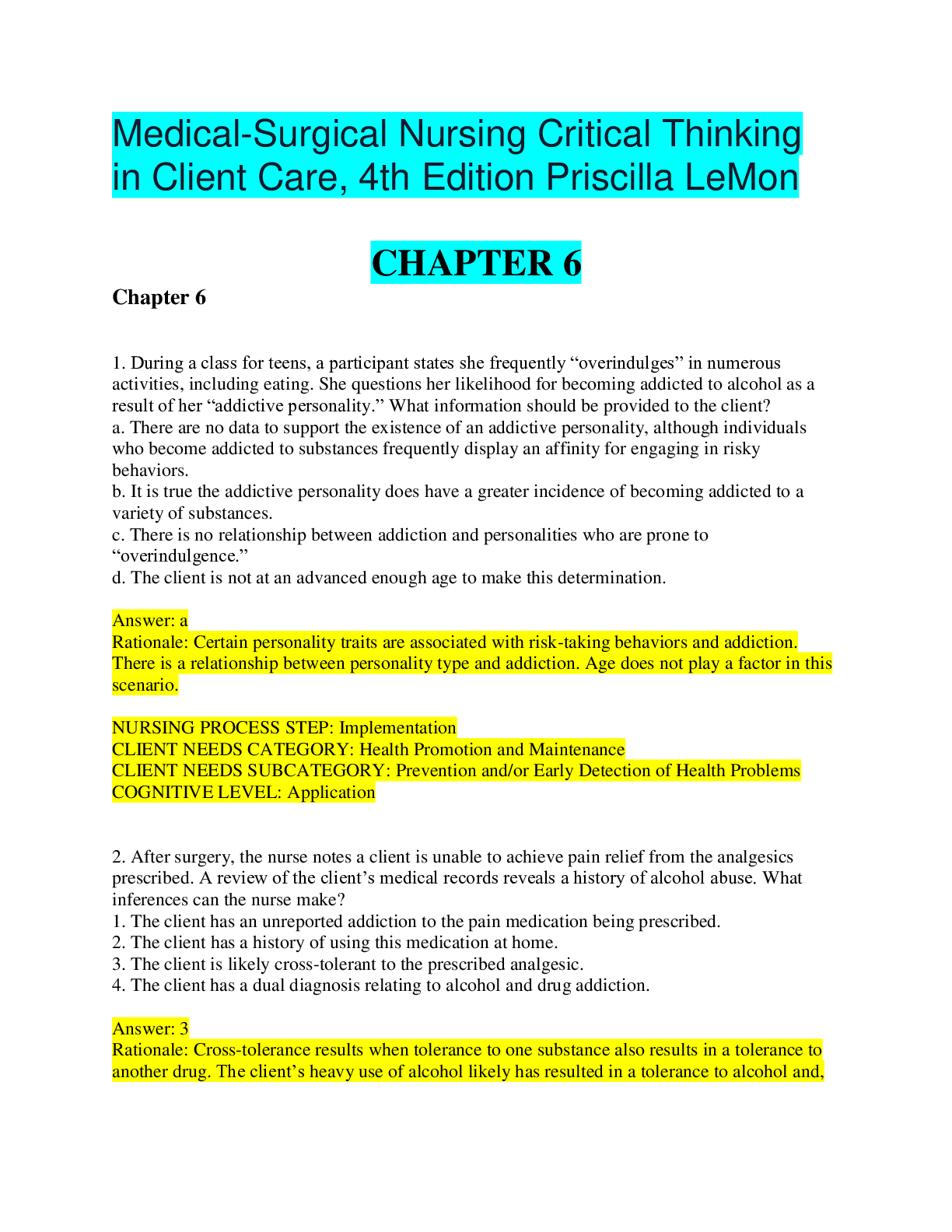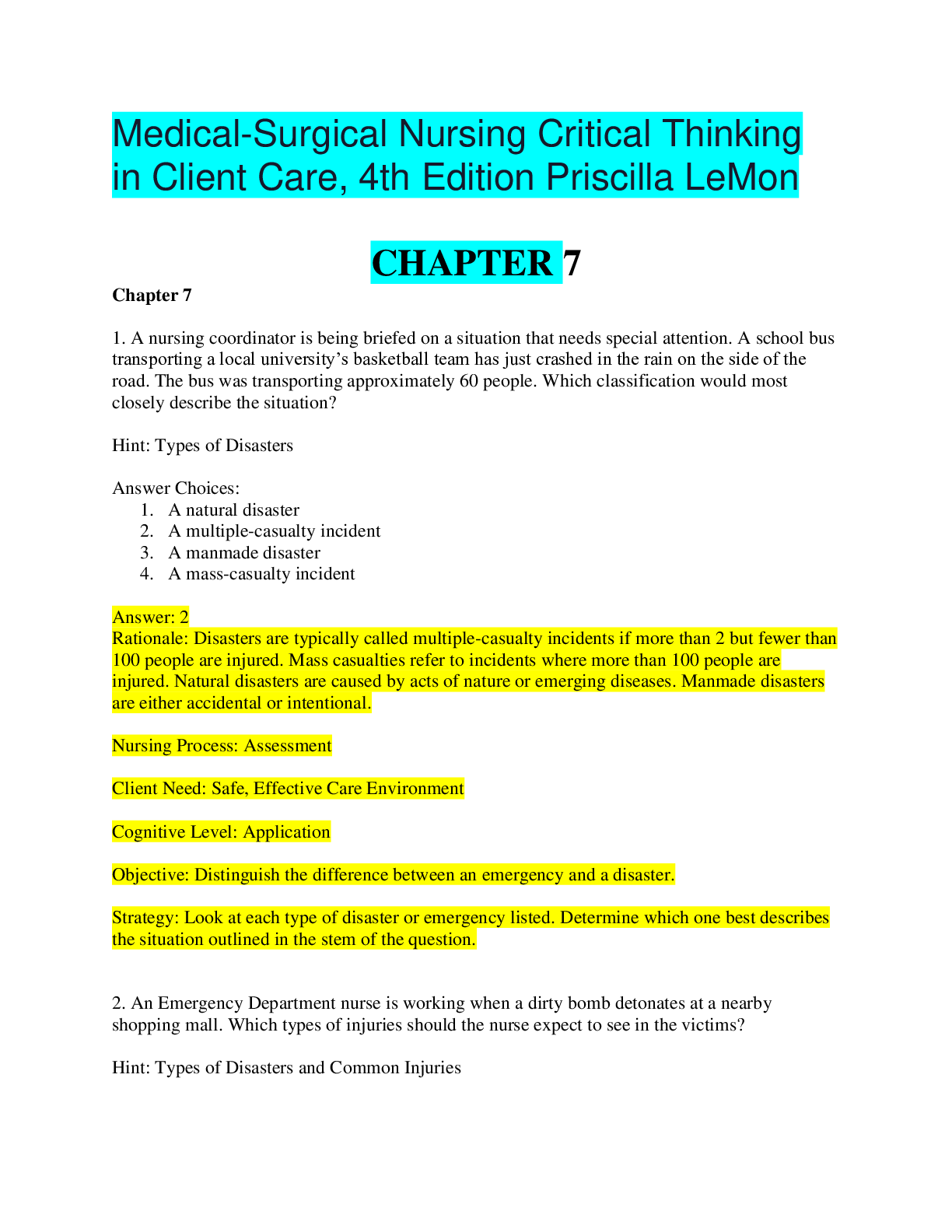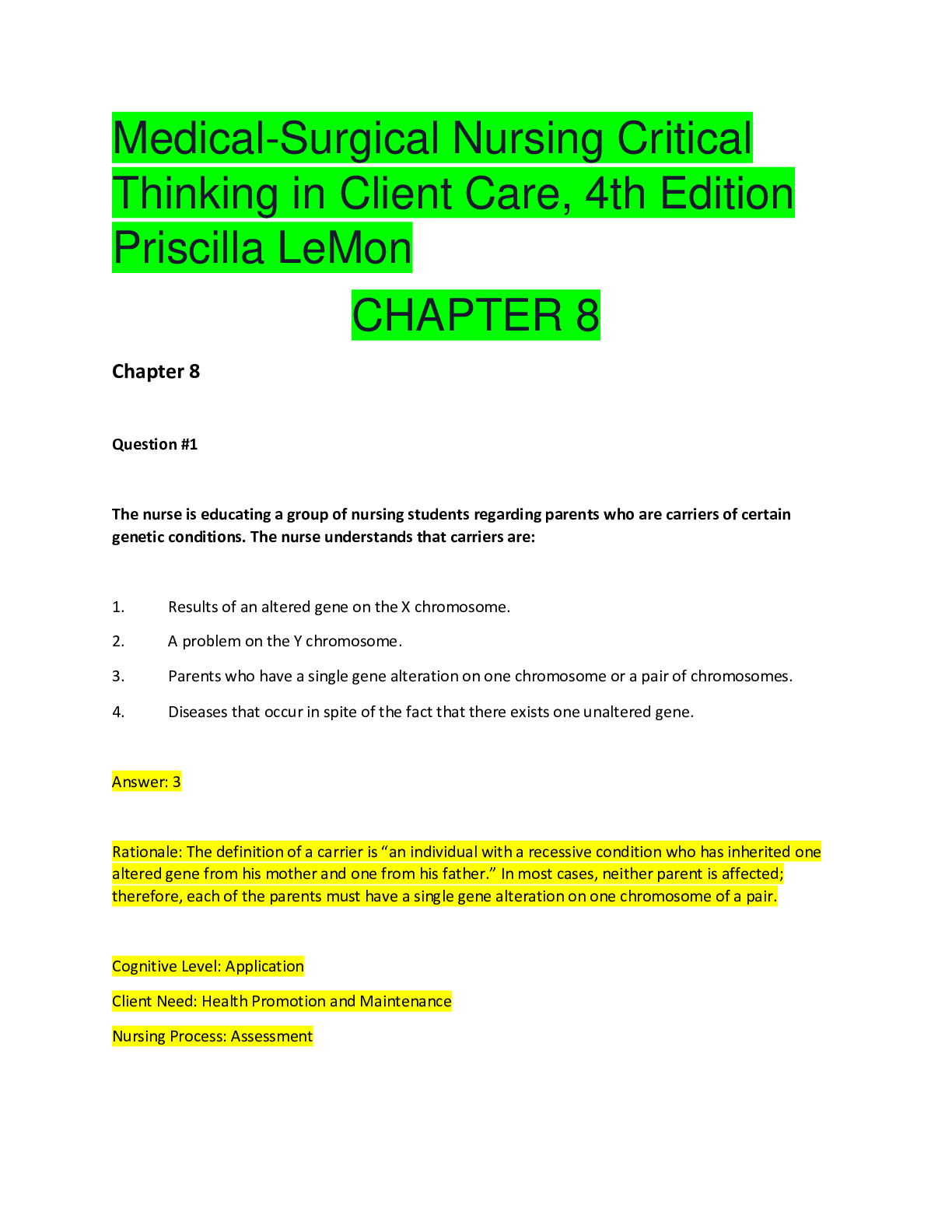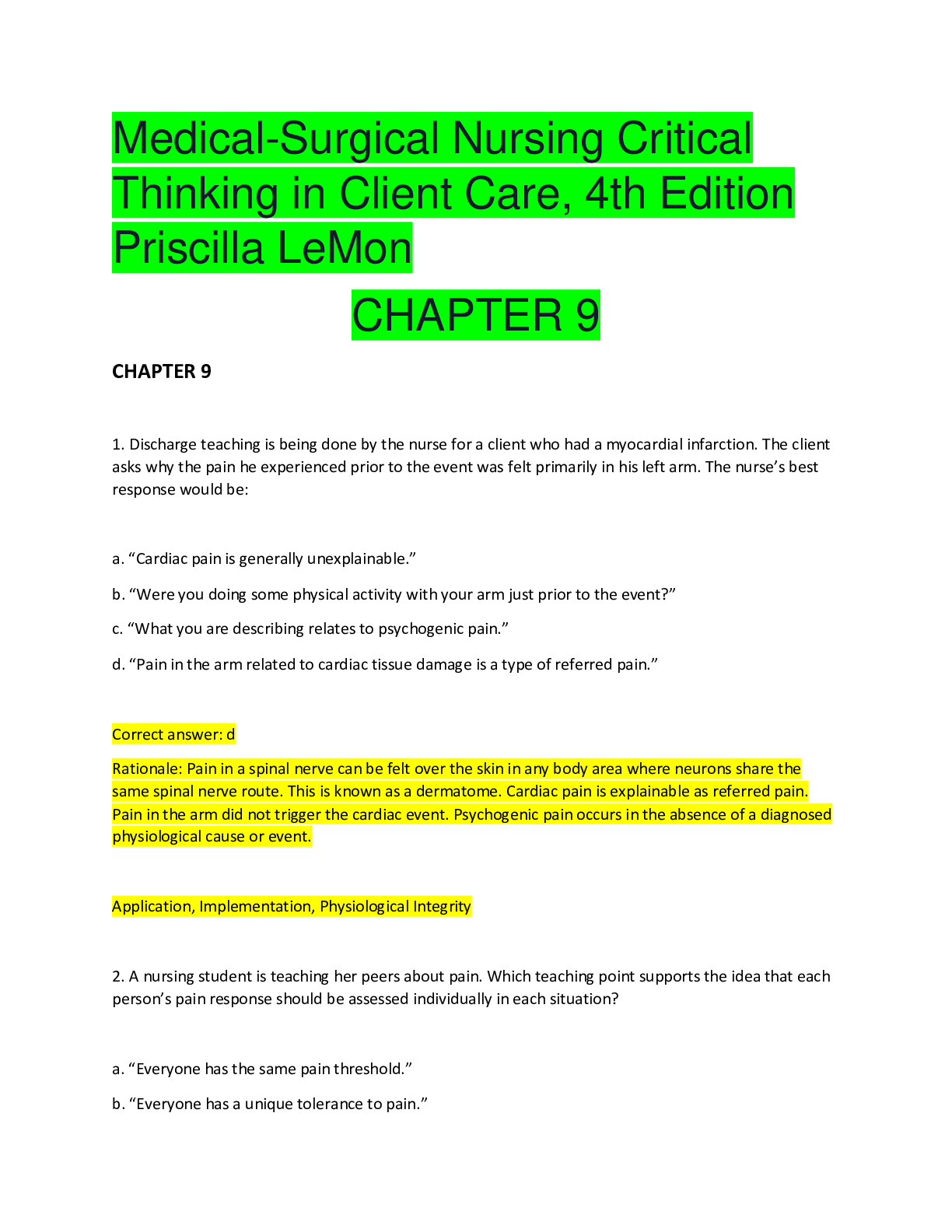Biology > QUESTIONS & ANSWERS > Fresno City College > BIOLOGY 102 > Fresno City College. BIOLOGY 102. Medical-Surgical Nursing Criti (All)
Fresno City College > BIOLOGY 102 > Fresno City College. BIOLOGY 102. Medical-Surgical Nursing Critical Thinking in Client Care, 4th Edition Priscilla LeMon CHAPTER 16 AND 17 (ALL CORRECT ANSWERS AND RATIONALE)
Document Content and Description Below
Medical-Surgical Nursing Critical Thinking in Client Care, 4th Edition Priscilla LeMon CHAPTER 16 AND 17 CHAPTER 16 1. A client reports intense itching of the scalp and face. Pediculosis is ident... ified in the hair and eyebrows. Which of the following should be included in the information provided to the client? 1. “You should start washing your hair more often to avoid this condition.” 2. “A single treatment will manage the infestation.” 3. “Infestations in the eyebrows will be treated by applying a thin layer of permethrin 1% cream (NIX) to the brows.” 4. “Apply the medication for at least 30 minutes before washing it off.” 2. A client diagnosed with scabies asks the nurse how he “caught” the disorder. What information should be provided to the client? 1. The disorder is transmitted by the feces of infected animals. 2. The disorder is transmitted by contact with infected persons or their possessions. 3. Scabies is a bacterial infection transmitted by direct contact with infected persons. 4. Scabies is a fungal infection transmitted by contact with infected respiratory secretions. 3. When planning care for the client newly diagnosed with herpes zoster, which of the following nursing diagnoses has the highest priority? 1. Health Maintenance, Ineffective 2. Anxiety 3. Deficient Knowledge 4. Pain, Acute 4. The client with herpes zoster reports difficulty resting at night. The nurse assists the client to manage this concern. Which of the following interventions will best aid the client? 1. Massage the irritated skin areas with lotion. 2. Apply powder to the lesions. 3. Encourage the client to take prescribed antipruritic agents approximately one hour before bedtime. 4. Use heavy bed linens to avoid chilling at night. 5. The mother of a teenaged female experiencing a severe case of acne voices concern about her daughter’s hygiene habits. Which of the following responses by the nurse is best? 1. “Your daughter needs to improve her facial hygiene to help in reducing the severity of the acne outbreaks.” 2. “The greatest culprit for the acne is dietary habits, not inadequate hygiene.” 3. “Are you embarrassed by her appearance?” 4. “What are your concerns about her hygiene practices?” 6. The physician has prescribed isotretinoin (Accutane) to a female client. Which of the following should be included in the instructions to the client? Select all that apply. 1. Take pills on an empty stomach to avoid nausea and vomiting. 2. Avoid prolonged exposure to sunlight. 3. Use a reliable form of contraception one month prior to and during use of the medication.. 4. Avoid the use of vitamin A supplements. 5. Use caution when driving at night. 7. A client at risk for the development of skin cancer is discussing sun exposure prevention with the nurse. What information should be included in the discussion? 1. Sunscreen is not needed on cloudy days. 2. The higher the sunscreen rating, the less the protection provided. 3. When swimming, sunscreen should be reapplied every four hours. 4. A higher-rated sunscreen is needed between 10 a.m. and 3 p.m. 8. When planning care for a client at risk for the development of pressure ulcers, which of the following should be included in the care? 1. Turn the client q.4h. 2. Massage pressure areas with lotion q.4h. 3. Use inflatable donut rings to reduce pressure on the sacrum. 4. Initiate a frequent toileting schedule. 9. A client with a history of tinea pedis reports concerns about developing the disorder again. Which of the following interventions suggested by the nurse will reduce the likelihood of a reoccurrence? 1. Begin to wear cotton undergarments 2. Wear sandal style footwear 3. Soak affected extremities in salted water nightly 4. Apply lotions to moisturize potential areas of outbreak daily 10. The charge nurse is preparing assignments for the shift. Two of the clients have been diagnosed with herpes zoster. When planning cares assignments, which of the following nurses should be assigned to care for these clients? 1. The nurse who is pregnant at 24 weeks’ gestation 2. The nurse who had chickenpox just one year ago 3. The nurse who has never had chickenpox 4. The nurse who is in her first trimester of pregnancy Chapter 17 1. A client is being evaluated in the Emergency Department after suffering severe burns to his torso and upper extremities. The nurse notes edema at the burned areas. Which of the following best describes the underlying cause for this manifestation? a. Reduced vascular permeability at the site of the burned area b. Decreased osmotic pressure in the burned tissue c. Increased fluids in the extracellular compartment d. Inability of the damaged capillaries to maintain fluids in the cell walls 2. The client having severe burns over more than half of his body has an indwelling catheter. When evaluating the client’s intake and output, which of the following should be taken into consideration? a. The amount of urine output will be greatest in the first 24 hours after the burn injury. b. The amount of urine will be reduced during the first 8 hours of the burn injury and will then increase as the diuresis begins. c. The amount of urine will be reduced in the first 24–48 hours, and will then increase. d. The amount of urine will be elevated due to the amount of intravenous fluids administered during the initial phases of treatment. COGNITIVE LEVEL: Analysis 3. The nurse is reviewing the laboratory results of the renal system for a client who experienced a major burn event on 45% of the body 24 hours ago. Which of the following results would the nurse expect to see? Select all that apply. a. Creatinine clearance reduced b. BUN reduced c. Uric acid decreased d. GFR reduced e. Specific gravity elevated 4. While working in the Emergency Department, the nurse is planning care for the client who has been admitted with a burn injury. Which of the following areas will be included in the plan of care? a. Fluid management b. Nutrition c. Psychosocial support d. Fluid resuscitation COGNITIVE LEVEL: Analysis 5. The physician has ordered the cleansing of a burn injury to a client’s ear. After cleaning the wound, which of the following steps should be completed next? a. Cover the ear with a sterile dressing. b. Provide a soft pillow to cushion the area. c. Use a foam doughnut to reduce pressure to the area. d. Place cotton gauze between the head and the ear to reduce the incidence of adhesions. 6. A client who has experienced a burn injury has been brought to the Emergency Department by family members. Which of the following interventions by the nurse is of the highest priority at this time? a. Determination of the type of burn injury b. Determination of the types of home remedies attempted prior to the client’s coming to the hospital c. Assessment of past medical history d. Determination of body weight 7. A client is scheduled to undergo grafting to a burn injury to the arm. Which of the following statements by the nurse should be included in the teaching prior to the procedure? a. “You will need to report any itching, as it might signal infection.” b. “Performing the procedure near the end of the hospitalization will reduce the incidence of infection and improve success of the procedure.” c. “The procedure will be performed in your room.” d. “You will begin to perform exercises to promote flexibility and reduce contractures after five days.” COGNITIVE LEVEL: Application 8. The client who has suffered a major burn injury is complaining of pain. Which of the following medications will be most therapeutic to the client? a. Morphine 10 mg IM q.3–4h. b. Morphine 4 mg IV q.5m. c. Meperidine 75 mg IM q.3–4h. d. Meperidine 50 mg PO q.3–4h. 9. When evaluating the laboratory values of the burn-injured client, which of the following can be anticipated? a. Elevated hemoglobin and elevated hematocrit levels b. Elevated hemoglobin and decreased hematocrit levels c. Decreased hemoglobin and decreased hematocrit levels d. Decreased hemoglobin and elevated hematocrit levels 10. The burn-injured client has been prescribed silver nitrate. Which of the following nursing interventions should be included for the client? a. Monitor daily weight. b. Prepare to change the dressings every two hours. c. Report black skin discolorations. d. Push fluid intake. COGNITIVE LEVEL: Analysis 11. The nurse is evaluating the adequacy of the burn-injured client’s nutritional intake. Which of the following laboratory values is the best indicator of nutritional status? a. Creatine phosphokinase (CPK) b. BUN levels c. Glycosuria d. Hemoglobin 12. When monitoring the vital signs of the client who has experienced a major burn injury, the nurse notes a heart rate of 112 and a temperature of 99.9°F. Which of the following best describes the findings? a. The client is demonstrating manifestations consistent with the onset of an infection. b. The client is demonstrating manifestations consistent with an electrolyte imbalance. c. These values are normal for the client’s post–burn injury condition. d. The client is demonstrating manifestations consistent with renal failure. Hint: Risk for Infection Strategy: Utilize knowledge of the pathophysiology of burn injuries and the process of elimination to select the correct answer. Objective: Discuss the systemic pathophysiologic effects of a major burn and the stages of burn wound healing. CLIENT NEEDS CATEGORY: Physiological Integrity CLIENT NEEDS SUBCATEGORY: Physiologic Adaptation COGNITIVE LEVEL: Analysis 13. After the skin graft procedure to the leg, the client is returned to the burn care unit. When positioning the client, which of the following positions will be most therapeutic for the client? a. Elevate the HOB 30 degrees. b. Elevate the affected extremity. c. Maintain the HOB flat. d. Place the client flat with the affected extremity abducted. 14. A client has presented with a burn injury. The injury site is pale and waxy with large flat blisters. The client asks questions about the severity of the injury and how long it will take for this injury to heal. Based upon your knowledge, what information should be provided to the client? a. The wound is a partial-thickness burn, and could take up to two weeks to heal. b. The wound is a superficial burn, and will take up to three weeks to heal. c. The wound is a deep partial-thickness burn, and will take more than three weeks to heal. d. Wound healing is individualized. NURSING PROCESS STEP: Diagnosis CLIENT NEEDS CATEGORY: Physiological Integrity CLIENT NEEDS SUBCATEGORY: Physiologic Adaptation COGNITIVE LEVEL: Application [Show More]
Last updated: 1 year ago
Preview 1 out of 18 pages
Instant download

Buy this document to get the full access instantly
Instant Download Access after purchase
Add to cartInstant download
Reviews( 0 )
Document information
Connected school, study & course
About the document
Uploaded On
Apr 13, 2020
Number of pages
18
Written in
Additional information
This document has been written for:
Uploaded
Apr 13, 2020
Downloads
0
Views
36













